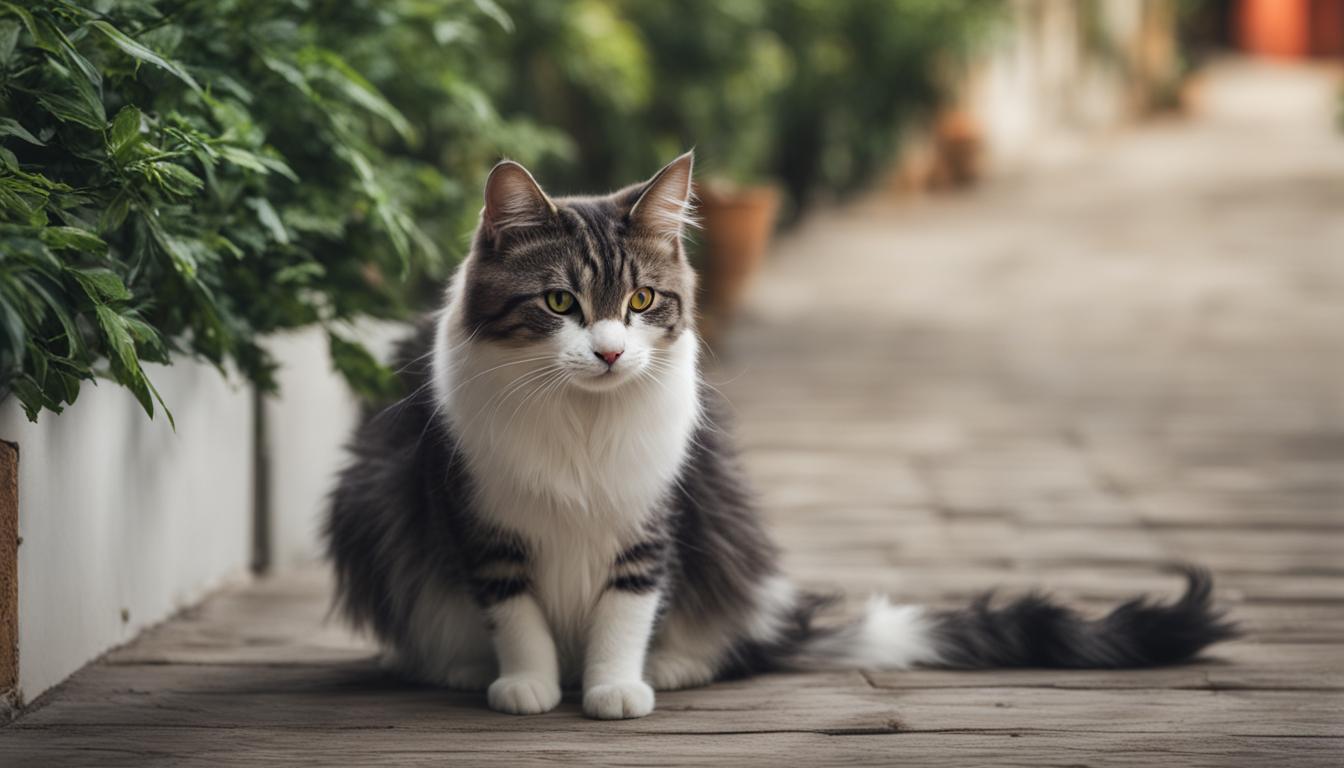As a cat lover and owner, I’ve always been fascinated by the intricate world of feline behavior. One aspect that particularly piqued my curiosity is cats’ territorial behavior. Have you ever wondered why your cat marks certain areas or gets defensive when confronted by intruders? I certainly have! In this article, I will delve into the fascinating world of cat territorial behavior, exploring their marking and defending techniques.
Understanding cat behavior is key to fostering a harmonious environment for both our furry friends and us. By unraveling the mysteries behind their territorial instincts, we can build a stronger bond and ensure their well-being. So, join me on this insightful journey as we explore the fascinating world of cat territorial behavior.
Key Takeaways:
- Cats’ territorial behavior is a natural instinct involving marking their territory through scent and defending it from intruders.
- Recognizing the signs of territorial behavior can help us understand when a cat is feeling threatened or anxious.
- Managing cat territorial behavior involves creating a safe and enriched environment, establishing multiple resources, and seeking professional guidance if needed.
- Outdoor cats have their own territories and engage in natural marking behaviors to establish and defend their territory.
- In multi-cat households, territorial conflicts can arise, but providing adequate resources and gradual introductions can minimize stress.
Signs of Cat Territorial Behavior
Understanding the signs of cat territorial behavior is crucial for cat owners to recognize when their feline companions are marking their territory or feeling threatened. Cats communicate their territorial instincts through various behaviors that can provide valuable insights into their emotional state. By being aware of these signs, cat owners can take appropriate steps to manage territorial aggression and anxiety in their pets.
1. Scent Marking:
One of the most common signs of territorial behavior in cats is scent marking. Cats have scent glands in their paws, cheeks, and tails, and they use these glands to leave their scent on objects and surfaces in their territory. This behavior serves as a way for cats to communicate their ownership and establish boundaries. Owners may notice their cats rubbing their cheeks against furniture, walls, or even against their legs to mark them as their territory.
2. Aggression Towards Intruders:
Cats are known for their independence and can become aggressive when they feel their territory is being invaded. This aggression can be displayed towards other cats, animals, or even humans. Common aggressive behaviors include hissing, growling, swatting, or biting. Some cats may also display territorial aggression by blocking access to certain areas or objects in the house.
3. Resource Guarding:
Cats may exhibit territorial behavior by guarding their resources, such as food, water bowls, or sleeping areas. They may become possessive and display aggressive behavior if another pet or human approaches their resources. This behavior stems from their need to protect what they perceive as their territory and can lead to conflicts in multi-pet households.
In summary, cat territorial behavior can manifest through signs such as scent marking, aggression towards intruders, and resource guarding. Recognizing these behaviors can help cat owners understand their cats’ needs and take appropriate actions to reduce territorial stress and promote a peaceful environment for all.
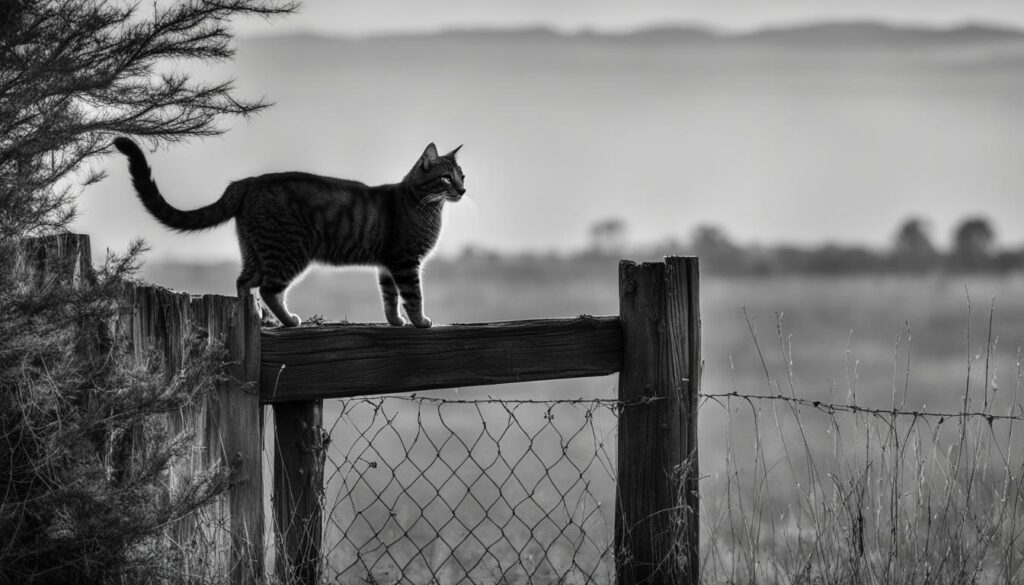
Managing Cat Territorial Behavior
When it comes to managing cat territorial behavior, prevention is key. By implementing various strategies, cat owners can effectively reduce territorial marking, minimize territorial stress, and manage aggression in their feline companions.
Creating a Safe and Enriched Environment
One of the first steps in managing cat territorial behavior is to provide a safe and enriched environment. This includes offering multiple litter boxes, scratching posts, and resting areas throughout the house. By giving each cat their own designated space and resources, territorial conflicts can be minimized.
Additionally, environmental enrichment such as interactive toys, puzzle feeders, and vertical spaces can help alleviate stress and provide mental stimulation for cats. A stimulated and enriching environment reduces the likelihood of territorial marking and aggressive behavior.
Establishing Multiple Resources
In multi-cat households, it’s important to establish multiple resources to prevent resource guarding and territorial disputes. Each cat should have access to its own food and water bowls, litter boxes, and resting areas. This ensures that cats do not feel the need to mark or defend resources, reducing territorial stress.
Gradual Introductions and Positive Reinforcement
When introducing a new cat to the household, it’s essential to do so gradually and carefully. This helps prevent territorial conflicts and reduces stress for all cats involved. Gradual introductions allow cats to become familiar with each other’s scents and presence, promoting a more harmonious relationship.
Positive reinforcement is also a valuable tool in managing cat territorial behavior. Rewarding desirable behavior such as using the litter box, engaging in playtime, and interacting peacefully with other cats reinforces positive associations and helps reduce territorial aggression.
By implementing these strategies and seeking professional guidance when necessary, cat owners can effectively manage cat territorial behavior, prevent territorial marking, reduce territorial stress, and promote a peaceful and harmonious living environment for their feline companions.
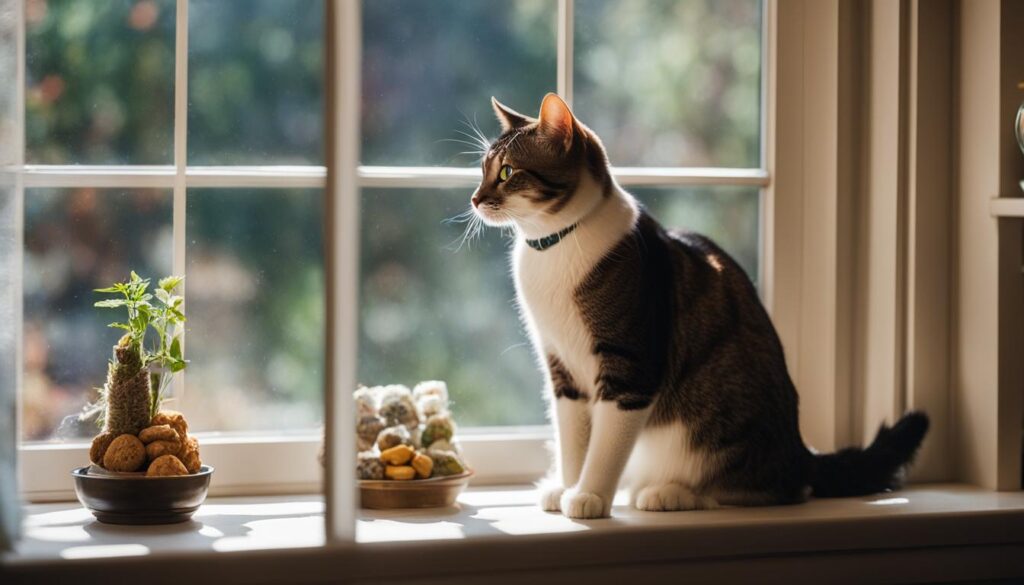
Understanding Outdoor Cat Territory
Cats are independent creatures that have a natural instinct to explore and mark their territory. When allowed to venture outdoors, cats engage in various behaviors that are specific to their outdoor environment. Understanding outdoor cat behavior and territory marking is crucial for cat owners who want to provide a safe and enriching outdoor experience for their feline companions.
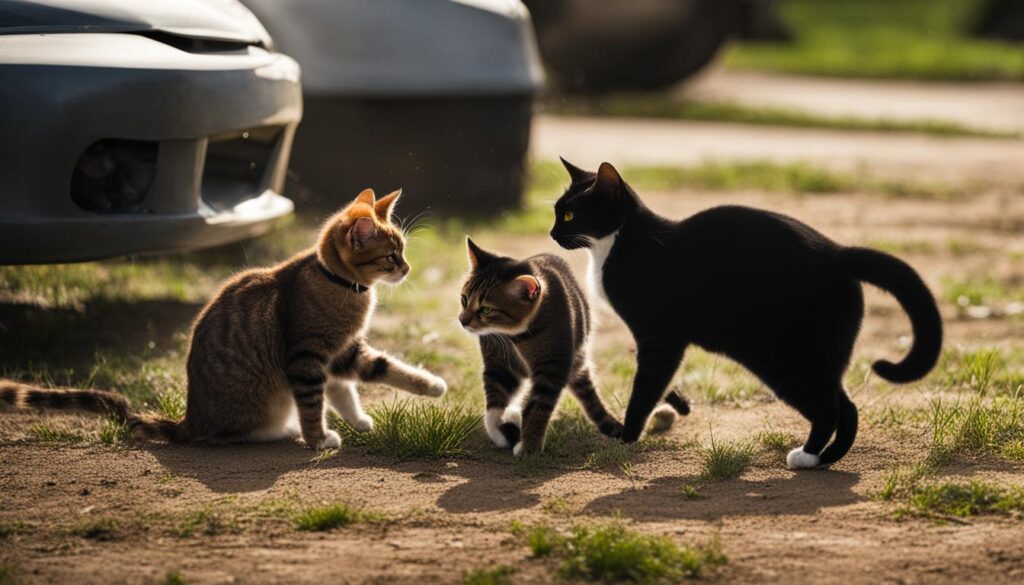
Outdoor Cat Behavior
Outdoor cats exhibit different behaviors compared to their indoor counterparts. They engage in activities such as hunting, exploring, and marking their territory. These behaviors are essential for cats to fulfill their natural instincts and maintain a sense of security in their outdoor surroundings.
When exploring their territory, outdoor cats use various sensory cues to mark their presence. They may scratch trees or other surfaces, leaving visible marks and scents as a way of claiming their territory. Additionally, outdoor cats may also engage in urine spraying to communicate their presence and establish boundaries.
Outdoor Cat Territory
The territory of an outdoor cat can vary in size depending on factors such as available resources and the presence of other cats in the area. Outdoor cat territories can overlap, leading to interactions and potential conflicts with neighboring cats. It is important to note that outdoor cat territories are fluid and can change based on environmental factors and the presence of competing cats.
Understanding the dynamics of outdoor cat territory can help cat owners create a safe and supportive outdoor environment for their cats. By providing appropriate resources, such as outdoor shelters, feeding stations, and designated areas for scratching and marking, cat owners can help their outdoor cats feel secure and content in their territory.
Territorial Conflicts in Multi-Cat Homes
Living in a multi-cat household can be a rewarding experience, but it can also come with its fair share of challenges. One common issue that cat owners may encounter is territorial conflicts among their feline companions. These conflicts arise when cats feel the need to establish and defend their individual territories within the shared living space. Managing these conflicts is crucial for maintaining a harmonious environment and ensuring the well-being of all the cats involved.
Multi-cat households can be especially prone to territorial conflicts if there are limited resources available. Cats may feel the need to compete for essential resources such as food, water, litter boxes, and resting areas. This competition can lead to aggression, tension, and stress among the cats. To minimize territorial conflicts, it is important to provide an ample number of resources throughout the living space. Each cat should have access to their own food and water bowls, litter boxes, and comfortable resting areas. This ensures that cats do not feel the need to defend their territory and helps reduce the likelihood of conflicts.
Introducing new cats into a multi-cat household should be done gradually and carefully. Cats are highly territorial creatures, and sudden introductions can lead to intense conflicts. It is important to give the cats time to adjust to each other’s presence and scent before allowing direct interactions. Use scent swapping techniques, such as rubbing towels on each cat and exchanging them, to help them become familiar with each other’s scent. Additionally, provide separate safe spaces for each cat where they can retreat to if they feel overwhelmed or stressed. These safe spaces should include hiding spots, elevated perches, and comfortable resting areas. Giving cats their own territory within the shared living space can help prevent territorial conflicts.
Key Considerations for Managing Territorial Stress in Multi-Cat Homes
- Ensure an ample number of resources, such as food bowls, water bowls, litter boxes, and resting areas, are available for each cat.
- Introduce new cats gradually, allowing them time to adjust to each other’s presence and scent.
- Use scent swapping techniques to help cats become familiar with each other’s scent.
- Provide separate safe spaces for each cat where they can retreat to if they feel overwhelmed or stressed.
- Observe and monitor the cats’ behavior closely for any signs of aggression or tension.
- Seek professional guidance from a veterinarian or animal behaviorist if the territorial conflicts persist or escalate.
By implementing these strategies and taking proactive measures to manage territorial stress, cat owners can create a peaceful and harmonious environment in their multi-cat homes. Remember, understanding and addressing the needs of each individual cat is key to fostering a positive relationship among all the feline companions in the household.
Territorial Spraying in Cats
Managing territorial spraying behavior is essential for cat owners to maintain a clean and odor-free environment. This behavior, where cats mark their territory by urine spraying, is not limited to intact male cats but can also occur in spayed or neutered cats. Understanding the reasons behind this behavior and implementing appropriate management techniques can help prevent and address territorial spraying in cats.
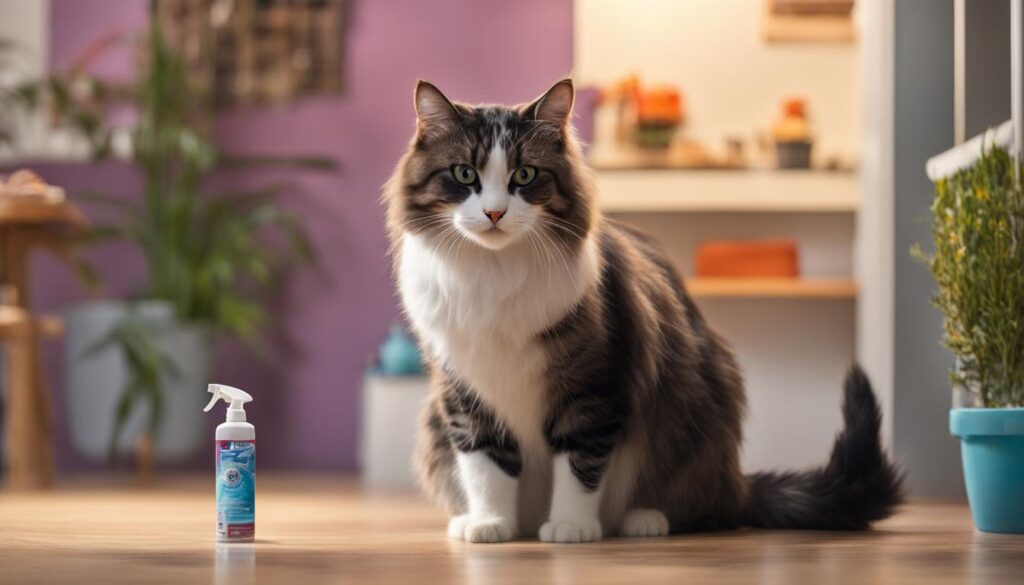
Cat urine marking behavior is often a result of territorial instincts. Cats use urine spraying as a way to communicate with other cats, establish their territory, and assert dominance. This behavior can be triggered by various factors, including the presence of other cats in the environment, changes in routine or environment, stress, or anxiety.
Understanding the reasons behind territorial spraying is crucial for effectively managing this behavior. Cats may spray in response to a perceived threat, to mark their territory, or to attract a mate. By identifying the underlying cause, cat owners can implement targeted strategies to prevent marking behavior and redirect their cat’s behavior in a more desirable way.
Preventing marking behavior in cats involves a multifaceted approach. Creating a secure and enriched environment, providing sufficient resources such as litter boxes, scratching posts, and perches, and ensuring regular play and social interaction can help alleviate stress and reduce the likelihood of territorial spraying. Additionally, neutering or spaying cats can significantly reduce marking behavior, as it minimizes their hormonal drive to mark territory.
By understanding the factors that contribute to territorial spraying and implementing appropriate management techniques, cat owners can create a peaceful and odor-free environment for both their cats and themselves. If the behavior persists or becomes a significant issue, consulting with a veterinarian or a feline behavior specialist can provide valuable guidance and support.
Reducing Territorial Stress in Cats
Creating a peaceful and stress-free environment for our feline friends is essential for their overall well-being. Cats are highly sensitive creatures, and territorial stress can greatly impact their behavior and happiness. By focusing on reducing stress and promoting a harmonious atmosphere, we can ensure that our cats thrive and enjoy their lives to the fullest.
One effective way to reduce territorial stress in cats is to provide them with an enriched environment. This includes offering plenty of vertical spaces, such as cat trees or shelves, where they can climb and observe their surroundings. Providing hiding spots, such as cozy cat beds or enclosed spaces, also gives them a sense of security and helps alleviate stress.
Additionally, engaging in interactive play sessions with our cats can help channel their energy and provide mental stimulation. Using toys that mimic hunting behavior, such as feather wands or puzzle feeders, not only helps keep cats physically active but also satisfies their instinctual needs. Regular playtime can go a long way in reducing territorial stress and promoting overall well-being.
Another helpful tool in reducing territorial stress is the use of pheromone products. Pheromones are chemical signals that cats naturally produce to communicate and establish their territory. Synthetic pheromone products, available in forms such as sprays, diffusers, or collars, can help create a calming environment for cats and reduce their stress levels.
| Tips for Reducing Territorial Stress in Cats |
|---|
| Provide vertical spaces and hiding spots |
| Engage in interactive play sessions |
| Use pheromone products |
| Establish a consistent routine |
Establishing a consistent routine is also crucial in reducing territorial stress. Cats are creatures of habit and thrive when they know what to expect. By maintaining a regular feeding schedule, playtime routine, and providing a consistent environment, we can help our cats feel safe, secure, and less likely to experience territorial stress.
Reducing territorial stress in cats is a continuous process that requires patience, understanding, and a proactive approach. By implementing these strategies, we can create a peaceful and harmonious environment for our furry companions, promoting their well-being and strengthening the bond we share.
Conclusion
Understanding and managing cat territorial behavior is key to cultivating a harmonious relationship with our feline friends. As responsible cat owners, it is crucial that we delve into the depths of their instincts, familiarize ourselves with the signs of territorial behavior, and take appropriate steps to address any challenges that arise.
By recognizing the nuances of cat behavior, we can effectively manage their territorial instincts. From creating a safe and enriched environment to seeking professional guidance when needed, there are various strategies at our disposal. Building a harmonious relationship requires patience, understanding, and a willingness to adapt our approach.
Managing cat behavior goes beyond simply curbing unwanted habits; it means fostering a strong bond and deepening our connection with our feline companions. So let’s embark on this journey with curiosity and dedication, forever striving to build a peaceful coexistence where both cats and humans can thrive.
FAQ
What is territorial behavior in cats?
Territorial behavior is a natural instinct in cats, where they mark their territory through scent and defend it from intruders.
How do cats display territorial behavior?
Cats display territorial behavior through scent marking, aggression towards intruders, resource guarding, and vocalizations.
What strategies can help manage territorial behavior in cats?
Strategies such as creating a safe and enriched environment, establishing multiple resources, gradual introductions, positive reinforcement, and seeking professional guidance can help manage territorial behavior in cats.
Do outdoor cats have their own territory?
Yes, outdoor cats have their own territory and engage in natural marking behaviors to establish and defend it.
How can territorial conflicts be managed in multi-cat households?
Providing sufficient resources, separate safe spaces, and introducing new cats gradually can help minimize territorial conflicts in multi-cat households.
Why do cats engage in territorial spraying?
Territorial spraying is a common behavior in intact male cats and can also occur in spayed or neutered cats as a form of marking their territory.
How can territorial stress in cats be reduced?
Reducing territorial stress in cats can be achieved by creating a peaceful and enriched environment, providing mental and physical stimulation, using pheromone products, and maintaining a consistent routine.
Why is understanding and managing cat territorial behavior important?
Understanding and managing cat territorial behavior is crucial for creating a harmonious relationship between cats and humans, promoting a sense of well-being in cats, and preventing potential conflicts.


